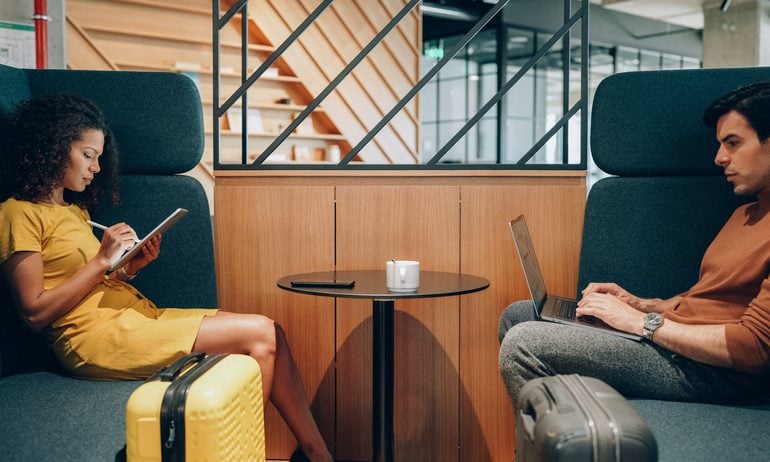Ask a Travel Nerd: Are Airport Lounges Overrated?
These lounges might be victims of their own success. Here's how to cope.

Many or all of the products on this page are from partners who compensate us when you click to or take an action on their website, but this does not influence our evaluations or ratings. Our opinions are our own.
I’ll admit, I used to feel a little smug while walking into an airport lounge. Exiting the chaos of the main terminal for the peaceful, snack-filled serenity of the lounge made me feel like I had figured it all out.
These days: Not so much.
I hurriedly ate my food while standing in a corner and fled for the relative peace of the terminal.
I visited the American Express Centurion Lounge during my last visit to Dallas-Fort Worth International Airport and had to wait 30 minutes to get in. By the time I was granted entry and had waited in a snaking line for my (admittedly decent) food, I couldn’t find a seat in the lounge. Bedraggled passengers had spread themselves out over multiple chairs, creating makeshift forts with their suitcases and jackets in a desperate attempt to sleep.
It felt more like a disaster zone than an exclusive club.
Yes, crocodile tears for the poor travel writer who can’t eat his kale salad peacefully. But the point is: The secret is out on travel lounges. Are they even still worth the hype?
Overcrowding problems
Airport lounges are struggling under the weight of their success. Among frequent travelers, 57% visit airport lounges at some point in their travels, according to a 2022 survey of more than 8,500 air travelers by Airport Dimensions, a shared-use airport lounge creator and operator.
And, while new lounges are frequently opening, supply hasn’t kept up with demand. Priority Pass — an airport lounge subscription included with many premium travel credit cards — used to mean subscribers could access these lounges around the world. Now, especially at U.S. lounges, “No Priority Pass” signs are a dreaded and common feature of many check-in desks.
According to the same Airport Dimensions survey, 30% of travelers who access an airport lounge do so with a subscription like Priority Pass. That’s more than the 25% who get it through their airline ticket (i.e., first- and business-class fares) and the 19% who get it from their elite airline status level.
Lounges are taking steps to mitigate these crowds. American Express Centurion Lounges recently amended the guest policy, effectively making it harder to bring in multiple guests using the same account. And Delta Sky Clubs now limit visits to three hours unless you’re in a connecting city.
Still, these are ad-hoc solutions that don’t address the core problem: More people want into these lounges, and not enough exist. Delta even has an FAQ on its Sky Club page, reading, “Why are Clubs so crowded these days?”
Eesh.
Are lounges worth it?
If you thought last year’s travel landscape was bleak, this summer could be even worse. Already, only 76.9% of flights arrived on time between January and March of this year, according to the U.S. Department of Transportation (up from 76.4% in the same period from 2022).
That means many travelers are missing connections, waiting for delays and desperately seeking a quiet corner to munch on their airport grub.
Of course, whether airport lounges are worth it depends on how you’re accessing them. Here’s how I think about it:
Paying to enter: Rarely makes sense. A one-day pass to an American Airlines Admirals Club costs $79, for example. That’s a lot of cheese for some crackers and cheese.
Using an elite status or fare class benefit: A no-brainer. If airlines give you something for free, always take it (even if you don’t like cookies).
Getting a credit card for the lounge access: Tricky. Because these lounges will be available to anyone with the same card, they will likely be crowded almost by default. Lounge access should be a nice add-on benefit, not the main reason for getting a card.
And then there’s the squishy question of personal preferences. For example, I don’t drink alcohol, so I always feel like I’m getting a little short-changed on my lounge visits. No amount of iced tea makes me feel like I’m getting my money’s worth.
The real benefit for me is peace and quiet and somewhere to work productively. So if lounges are packed or full of screaming kids, they’re worse than an empty gate.
What I’m saying is this: Someone who likes noisy dive bars will love airport lounges.
The airport terminal could do better
The real problem isn’t crowded lounges. It’s how inhumane the airport itself can be (though charming airports do exist).
One of the biggest problems is noise pollution. We take it for granted that blaring, airport-wide announcements are made every few minutes. In fact, one of the most enjoyable aspects of stepping into a lounge is the lack of these announcements.
But it doesn’t have to be like this. Several airports, primarily in international cities, are embracing the idea of a “silent airport,” where announcements and other interruptions are less frequent. You can test this in the U.S. if you fly out of San Francisco International Airport.
Cutting noise won’t turn every packed gate into an earthly paradise, but it highlights how easy it would be to make airports less harrowing and lounges less (relatively) appealing.
I won’t hold my breath for that day, but I won’t be renewing my lounge-granting credit cards next year, either. I don’t need to pay money to wait in line.
How to maximize your rewards
You want a travel credit card that prioritizes what’s important to you. Here are some of the best travel credit cards of 2025:
Flexibility, point transfers and a large bonus: Chase Sapphire Preferred® Card
No annual fee: Wells Fargo Autograph® Card
Flat-rate travel rewards: Capital One Venture Rewards Credit Card
Bonus travel rewards and high-end perks: Chase Sapphire Reserve®
Luxury perks: The Platinum Card® from American Express
Business travelers: Ink Business Preferred® Credit Card
Chase Sapphire Preferred® Card
Travel
Dining
🔥 Huge highest-ever bonus on NerdWallet's 2025 Best All-Purpose Travel Rewards Card is back. Don't miss your rare chance to: Earn 100,000 points when you spend $5,000 on purchases in the first three months. That's worth at least $1,250 toward travel booked through Chase.


